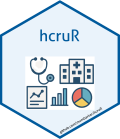

hcruR is an R package to help health economists and RWE analysts estimate and compare healthcare resource utilization (HCRU) from observational healthcare data, such as claims or electronic health records.
You can install the development version of hcruR from GitHub with:
# Install from GitHub (after you upload the repo)
# install.packages("devtools")
devtools::install_github("mumbarkar/hcruR")
# install.packages("pak")
pak::pak("mumbarkar/hcruR")This is a basic example which shows you how to solve a common problem:
This is a basic example which shows you how to solve a common problem:
# Load library
library(hcruR)
## Generate HCRU summary using dplyr (this can be used for create HCRU plots)
# Load sample data
data(hcru_sample_data)
data <- hcru_sample_data
head(hcru_sample_data)
# Estimate HCRU
hcru_summary <- estimate_hcru(data,
cohort_col = "cohort",
patient_id_col = "patient_id",
admit_col = "admission_date",
discharge_col = "discharge_date",
index_col = "index_date",
visit_col = "visit_date",
encounter_id_col = "encounter_id",
setting_col = "care_setting",
cost_col = "cost_usd",
readmission_col = "readmission",
time_window_col = "period",
los_col = "length_of_stay",
custom_var_list = NULL,
pre_days = 180,
post_days = 365,
readmission_days_rule = 30,
group_var_main = "cohort",
group_var_by = "care_setting",
test = NULL,
timeline = "Pre",
gt_output = FALSE)
hcru_summary
## Generate HCRU summary using gtsummary (a publication ready output)
# Estimate HCRU
hcru_summary_gt <- estimate_hcru(data,
cohort_col = "cohort",
patient_id_col = "patient_id",
admit_col = "admission_date",
discharge_col = "discharge_date",
index_col = "index_date",
visit_col = "visit_date",
encounter_id_col = "encounter_id",
setting_col = "care_setting",
cost_col = "cost_usd",
readmission_col = "readmission",
time_window_col = "period",
los_col = "length_of_stay",
custom_var_list = NULL,
pre_days = 180,
post_days = 365,
readmission_days_rule = 30,
group_var_main = "cohort",
group_var_by = "care_setting",
test = NULL,
timeline = "Pre",
gt_output = TRUE)
hcru_summary_gt
## Generate the HCRU plot for average visits by cohort and time-line
# Calculate the average visits
sum_df1 <- hcru_summary$`Summary by settings using dplyr` |>
dplyr::group_by(
.data[["time_window"]],
.data[["cohort"]],
.data[["care_setting"]]) |>
dplyr::summarise(
AVG_VISIT = mean(.data[["Visits"]], na.rm = TRUE), .groups = "drop")
# Load the plot_hcru function
p1 <- plot_hcru(
summary_df = sum_df1,
x_var = "time_window",
y_var = "AVG_VISIT",
cohort_col = "cohort",
facet_var = "care_setting",
facet_var_n = 3,
title = "Average visits by domain and cohort",
x_label = "Healthcare Setting (Domain)",
y_label = "Average visit",
fill_label = "Cohort"
)
p1
## Generate HCRU plot for average cost by cohort and timeline
# Calculate the total cost
df2 <- hcru_summary$`Summary by settings using dplyr` |>
dplyr::group_by(
.data[["time_window"]],
.data[["cohort"]],
.data[["care_setting"]]) |>
dplyr::summarise(
AVG_COST = sum(.data[["Cost"]], na.rm = TRUE), .groups = "drop")
p2 <- plot_hcru(
summary_df = df2,
x_var = "time_window",
y_var = "AVG_COST",
cohort_col = "cohort",
facet_var = "care_setting",
facet_var_n = 3,
title = "Average cost by domain and cohort",
x_label = "Healthcare Setting (Domain)",
y_label = "Average cost",
fill_label = "Cohort"
)
p2estimate_hcru() estimates of healthcare resource
utilization (HCRU) from electronic health record data across various
care settings (e.g., IP, OP, ED/ER). It provides descriptive summaries
of patient counts, encounters, costs, length of stay, and readmission
rates for pre- and post-index periods
| Argument | Type | Description |
|---|---|---|
data |
data.frame |
Input claims dataset |
cohort_col |
character |
Column name for cohort group |
patient_id_col |
character |
Column name for patient ID |
admit_col |
character |
Admission/start date column |
discharge_col |
character |
Discharge/end date column |
index_col |
character |
Index or anchor date for each patient |
visit_col |
character |
Visit or claim date |
encounter_id_col |
character |
Encounter or claim ID |
setting_col |
character |
Setting type (e.g., “IP”, “OP”, “ED”) |
cost_col |
character |
Column for cost data |
readmission_col |
character |
Readmission indicator column |
time_window_col |
character |
“Pre”/“Post” period column |
los_col |
character |
Length of stay column |
custom_var_list |
character |
Additional user-defined metrics (optional) |
pre_days |
numeric |
Days before index date (default = 180) |
post_days |
numeric |
Days after index date (default = 365) |
readmission_days_rule |
numeric |
Max days for qualifying readmission (default = 30) |
group_var_main |
character |
Main grouping variable (default = “cohort”) |
group_var_by |
character |
Secondary grouping variable (e.g., “care_setting”) |
test |
list |
Named list of tests for continuous vars (e.g.,
list(cost = "wilcox.test")) |
timeline |
character |
Time window label (e.g., “Pre”, “Post”) |
gt_output |
logical |
Whether to return a formatted gtsummary output (default
= TRUE) |
... |
... |
Additional arguments for gtsummary::tbl_summary() if
gt_output = TRUE |
return_type |
character |
Type of output to return: “dplyr” for dplyr summary, “gtsummary” for gtsummary output (default = “dplyr”) |
plot_hcru() provides the visualization of the events of
the settings/domains grouped by cohort and time window.
| Argument | Type | Description |
|---|---|---|
summary_df |
dataframe | Output from estimate_hcru() function. |
x_var |
character | Column name to plot on the x-axis (default
"period"). |
y_var |
character | Column name to plot on the y-axis (default
"Cost"). |
cohort_col |
character | Name of the column identifying cohorts (default
"cohort"). |
facet_var |
character | Column to generate subplots for (default
"care_setting"). |
facet_var_n |
numeric | Number of columns in the facet grid (default 3). |
title |
character | Title of the plot. |
x_lable |
character | Label for the x-axis. |
y_lable |
character | Label for the y-axis. |
fill_lable |
character | Label for the fill legend. |
This package includes a demo datasets for easy testing:
hcru_sample_data: 200 patients across 2 cohortshead(hcru_sample_data)Run the following to access the full walkthrough:
vignette("hcru-analysis", package = "hcruR")To contribute:
git clone https://github.com/mumbarkar/hcruR.git
cd hcruRThis package is licensed under the MIT License.